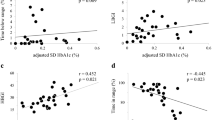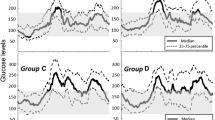Abstract
Glucose variability has recently been investigated in diabetic patients in several studies, but most of them considered only a few variability indicators and did not systematically correlate them with patients’ HbA1c levels and other important characteristics. In thus study, the correlations between HbA1c levels and metabolic control (average glucose, AG), glucose variability (SD, CONGA, MAGE, MODD, BG ROC), hyperglycemia (HBGI), hypoglycemia (LBGI) and postprandial (AUC PP) indices were investigated in patients with type 1 and type 2 diabetes. The study involved 68 patients divided into 3 groups as follows: 35 patients had type 1 diabetes (group 1); 17 had type 2 diabetes and were taking multiple daily injections (MDI) of insulin (group 2); and 16 patients had type 2 diabetes treated with OHA and/or basal insulin (group 3). The indicators were obtained over at least 48 h using a continuous glucose monitoring (CGM) system. HbA1c levels were measured at the baseline and after CGM. HbA1c correlated significantly with AG (r = 0.74), AUC PP (r = 0.69) and HBGI (r = 0.74), but only in type 1 diabetic patients. Patients with longstanding disease and type 1 diabetes had a greater glucose variability, irrespective of their HbA1c levels. Insulin therapy with MDI correlated strongly with HbA1c, but not with glucose variability. HbA1c levels identify states of sustained hyperglycemia and seem to be unaffected by hypoglycemic episodes or short-lived glucose spikes, consequently revealing shortcomings as a “gold standard” indicator of metabolic control. Glucose variability indicators describe the glucose profile of type 1 diabetic patients and identify any worsening glycemic control (typical of longstanding diabetes) more accurately than HbA1c tests.

Similar content being viewed by others
References
DCCT Research Group (1993) The effect of intensive treatment of diabetes on development and progression of long-term complications in insulin dependent diabetes mellitus. N Eng J Med 329:977–986
UK Prospective Diabetes Study group (1998) Intensive blood-glucose control with sulphonylureas or insulin compared with conventional treatment and risk of complications in patient with type 2 diabetes. Lancet 352:837–853
Dailey G (2007) Assessing glycemic control with self-monitoring of blood glucose and hemoglobin A(1c) measurements. Mayo Clin Proc 82(2):229–235
Ceriello A, Ihnat MA (2010) ‘Glycaemic variability’: a new therapeutic challenge in diabetes and the critical care setting. Diabet Med 27(8):862–867
Ceriello A (2005) Postprandial hyperglycemia and diabetes complications. Is it time to treat? Diabetes 54:1–7
Kovatchev BP, Cox DJ, Farhy LS, Straume M, Gonder-Frederick L, Clarke WL (2000) Episodes of severe hypoglycemia in type 1 diabetes are preceded and followed within 48 hours by measurable disturbances in blood glucose. J Clin Endocrinol Metab 85:4287–4429
Kudva YC, Basu A, Jenkins GD, Pons GM, Vogelsang DA, Rizza RA, Smith SA, Isley WL (2007) Glycemic variation and hypoglycemia in patients with well-controlled type 1 diabetes on a multiple daily insulin injection program with use of glargine and ultralente as basal insulin. Endocr Pract 13:244–250
Nathan DM, Kuenen J, Borg R, Zheng H, Schoenfeld D, Heine RJ, for the A1c-Derived Average Glucose (ADAG) Study Group (2008) Translating the A1C assay into estimated average glucose values. Diabetes Care 31(8):1473–1478
Siegelaar SE, Holleman F, Hoekstra JBL, DeVries JH (2010) Glucose variability, does it matter? Endocr Rev 31:171–182
Lee EY, Lee BW, Kim D, Lee YH, Kim KJ, Kang ES, Cha BS, Lee EJ, Lee HC (2011) Glycated albumin is a useful glycation index for monitoring fluctuating and poorly controlled type 2 diabetic patients. Acta Diabetol 48:167–172
Koga M, Saito H, Mukai M, Matsumoto S, Kasayama S (2010) Influence of iron metabolism indices on glycated haemoglobin but not glycated albumin levels in premenopausal women. Acta Diabetol 47:65–69
Koga M, Murai J, Saito H, Mukai M, Kasayama S (2010) Serum glycated albumin, but not glycated haemoglobin, is low in relation to glycemia in hyperuricemic men. Acta Diabetol 47:173–177
Koga M, Saito H, Mukai M, Otsuki M, Kasayama S (2009) Serum glycated albumin levels are influenced by smoking status, independent of plasma glucose levels. Acta Diabetol 46:141–144
Klonoff DC (2005) Continuous glucose monitoring: roadmap for 21st century diabetes therapy. Diabetes Care 28:1231–1239
Borg R, Kuenen JC, Carstensen B, Zheng H, Nathan D, Heine RJ, Nerup J, Borch-Johnsen K, Witte DR, the ADAG Study Group (2010) Associations between features of glucose exposure and HbA1c. The A1c-Derived Average Glucose (ADAG) study. Diabetes 59:1585–1590
Pickup JC, Kidd J, Burmiston S, Yemane N (2006) Determinants of glycaemic control in type 1 diabetes during intensified therapy with multiple daily insulin injections or continuous subcutaneous insulin infusion: importance of blood glucose variability. Diabetes Metab Res Rev 22:232–237
Greven WL, Beulens JW, Biesma DH, Faiz S, de Valk HW (2010) Glycemic variability in inadequately controlled type 1 diabetes and type 2 diabetes on intensive insulin therapy: a cross-sectional, observational study. Diabetes Technol Ther 12:695–699
Monnier L, Mas E, Ginet C, Michel F, Villon L, Cristol JP, Colette C (2006) Activation of oxidative stress by acute glucose fluctuations compared with sustained chronic hyperglycemia in patients with type 2 diabetes. JAMA 295(14):1681–1687
Kohnert KD, Augstein P, Heinke P, Zander E, Peterson K, Freyse EJ, Salzsieder E (2007) Chronic hyperglycemia but not glucose variability determines HbA1c levels in well-controlled patients with type 2 diabetes. Diabetes Res Clin Pract 77:420–426
Rodbard D (2009) New and improved methods to characterize glycemic variability using continuous glucose monitoring. Diabetes Technol Ther 11:551–565
Service FJ, Molnar GD, Rosevear JW, Ackerman E, Gatewood LC, Taylor WF (1970) Mean amplitude of glycemic excursions, a measure of diabetic instability. Diabetes 19:644–656
McDonnell CM, Donath SM, Vidmar SI, Werther GA, Cameron FJ (2005) A novel approach to continuous glucose analysis utilizing glycemic variation. Diabetes Technol Ther 7(2):253–263
Molnar GD, Taylor WF, Ho MM (1972) Day-to-day variation of continuously monitored glycaemia: a further measure of diabetic instability. Diabetologia 8(5):342–348
McCall AL, Cox DJ, Crean J, Gloster M, Kovatchev BP (2006) A novel analytical method for assessing glucose variability: using CGMS in type 1 diabetes mellitus. Diabetes Technol Ther 8:644–653
Kovatchev BP, Cox DJ, Gonder-Frederick LA, Clarke W (2006) Evaluation of a new measure of blood glucose variability in diabetes. Diabetes Care 29:2433–2438
Kovatchev BP, Cox DJ, Gonder-Frederick LA, Clarke WL (2002) Methods for quantifying and monitoring blood glucose profiles exemplified by an examination of blood glucose patterns in patients with type 1 and type 2 diabetes. Diabetes Technol Ther 4:295–303
Cox DJ, Kovatchev BP, Julian DM, Gonder-Frederick LA, Polonsky WH, Schlundt DG, Clarke WL (1994) Frequency of severe hypoglycemia in insulin-dependent diabetes mellitus can be predicted from self-monitoring blood glucose data. J Clin Endocrinol Metab 79:1659–1662
UK Hypoglycemia Study Group (2007) Risk of hypoglycaemia in types 1 and 2 diabetes: effects of treatment modalities and their duration. Diabetologia 50:1140–1147
Monnier L, Colette C, Mas E, Michel F, Cristol JP, Boegner C, Owens DR (2010) Regulation of oxidative stress by glycaemic control: evidence for an independent inhibitory effect of insulin therapy. Diabetologia 53:562–571
Rossetti P, Porcellati F, Fanelli CG, Perriello G, Torlone E, Bolli GB (2008) Superiority of insulin analogues versus human insulin in the treatment of diabetes mellitus. Arch Physiol Biochem 114(1):3–10
Monnier L, Colette C, Owens DR (2008) Glycemic variability: the third component of the dysglycemia in diabetes. Is it important? How to measure it? J Diabetes Sci Technol 2:1094–1100
Nardacci EA, Bode BW, Hirsch IB (2010) Individualizing care for the many: the evolving role of professional continuous glucose monitoring systems in clinical practice. Diabetes Educ 36:4S–19S
Kilpatrick ES, Rigby AS, Atkin SL (2010) Glucose variability and diabetes complication risk: we need to know the answer. Diabet Med 27:868–871
Conflict of interest
The authors have no competing financial interests to disclose.
Author information
Authors and Affiliations
Corresponding author
Additional information
Communicated by Antonio Secchi.
Rights and permissions
About this article
Cite this article
Sartore, G., Chilelli, N.C., Burlina, S. et al. The importance of HbA1c and glucose variability in patients with type 1 and type 2 diabetes: outcome of continuous glucose monitoring (CGM). Acta Diabetol 49 (Suppl 1), 153–160 (2012). https://doi.org/10.1007/s00592-012-0391-4
Received:
Accepted:
Published:
Issue Date:
DOI: https://doi.org/10.1007/s00592-012-0391-4




